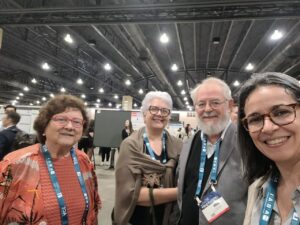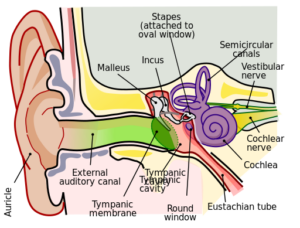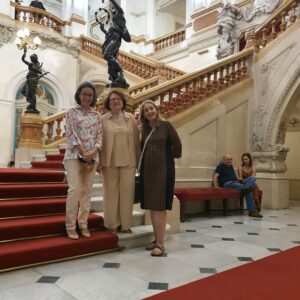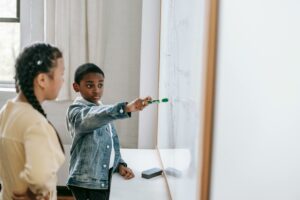Dear blog reader,
Our next contributor is one of a number of fantastic researchers in Brazil doing exciting and innovative work in symbolic language and thought. Specifically, Professor Ana Claudia Verdu has built her impressive career primarily through using behavior analysis, and equivalence more specifically, to teach hearing impaired populations with cochlear implants to read and write. I was quite blown away when I first started reading about Ana’s work. Not only is it incredibly innovative and exciting for the science, but it has a direct impact on real people’s lives and standards of living, overall providing a great demonstration of the power of our science in the real world. Not only that, but Ana’s story really embodies the collaboration and cooperation within and across disciplines that we are attempting to highlight within this series, as she recounts building links with speech and language therapists, hospital clinics, as well as with work within the discipline on naming. Anyway, as per usual I could drone on and on here, but I think the best thing for you, reader, would be for me to wrap this intro up and let you read Ana’s fascinating story. Enjoy!
Colin
About the author:
 Ana Claudia has a master’s degree and doctorate in Special Education from the Federal University of São Carlos (UFSCar). She is currently an Associate Professor at the Department of Psychology and the Postgraduate Course in Developmental and Learning Psychology (of which she was coordinator from 2017 to 2021) at Universidade Estadual Paulista (UNESP) and a researcher at the National Institute of Science and Technology on Behavior, Cognition and Teaching (INCT-ECCE). Professor Verdu is also a research fellow at the National Council for Scientific and Technological Development (CNPq), an associate editor for the journals Acta Comportamentalia (of which she was also Portuguese language editor from 2009 to 2011) and Revista Brasileira de Análise do Comportamento. Her primary areas of interest are the analysis of verbal and symbolic behavior.
Ana Claudia has a master’s degree and doctorate in Special Education from the Federal University of São Carlos (UFSCar). She is currently an Associate Professor at the Department of Psychology and the Postgraduate Course in Developmental and Learning Psychology (of which she was coordinator from 2017 to 2021) at Universidade Estadual Paulista (UNESP) and a researcher at the National Institute of Science and Technology on Behavior, Cognition and Teaching (INCT-ECCE). Professor Verdu is also a research fellow at the National Council for Scientific and Technological Development (CNPq), an associate editor for the journals Acta Comportamentalia (of which she was also Portuguese language editor from 2009 to 2011) and Revista Brasileira de Análise do Comportamento. Her primary areas of interest are the analysis of verbal and symbolic behavior.
Interdisciplinary Collaboration for Understanding Language Acquisition in Children with Hearing Impairments (clique aqui para a tradução em português deste blog)
Like many researchers, I have always been very interested in understanding why things are the way they are as an active process of experimentation. At university I studied Psychology, and from the very beginning, my main area of interest was research. During my undergraduate studies, I gained experience as a lab assistant in Experimental Behavior Analysis and developed my undergraduate research in the areas of stimulus control and the equivalence paradigm. As part of my activities, I assisted my first advisor in his research on contextual control over equivalence classes in individuals with intellectual disabilities. It was only during my master’s degree that I first had contact with the hearing-impaired population.

The behavior-analytic study of symbolic behavior in children with hearing impairments and cochlear implants is a relatively recent topic in the literature, conducted through a productive interface with speech-language pathologists as an interdisciplinary responsibility (Association for Behavior Analysis International, 2020). In Brazil, work in this area began within the Program for Supporting Centers of Excellence – PRONEX/MCT (1997-2004; 2004-2007). As a student, I participated in the first period of this program (1997-2004), during which I obtained my masters (2000) and doctoral (2004) degrees at the Federal University of São Carlos (UFSCar) under the guidance of Professor Deisy das Graças de Souza. The stimulating environment of UFSCar, interactions with graduate colleagues, co-supervision by Professor Jair Lopes Junior (UNESP), and the PRONEX context more generally (which included many well-known behavior-analytic researchers like Júlio de Rose in Brazil and William McIlvane in the United States), served as pillars for developing my research trajectory. Although the theme of my research always centred around stimulus control, my masters (1998-2000) focused on sequential training, ordinal classes, and contextual control in illiterate children. However, during my masters, I also closely followed the research of my colleague Wagner Rogério da Silva, whose masters research (1998-2000) was with children with hearing impairments and cochlear implants. Wagner’s masters work would constitute the first to approach behavior analysis and speech-language therapy through the study of symbolic functions acquired by auditory stimuli in children with recently restored hearing through cochlear implants. Besides the PRONEX researchers, UFSCar, and my co-supervision at UNESP, another important contributor was Professor Maria Cecília Bevilacqua (in memoriam) from the Cochlear Implant department of the Rehabilitation Hospital for Craniofacial Anomalies (HRAC/USP) who allowed patients to be research participants in the hospital space during the rehabilitation process. This team built a relationship between speech-language pathologists and behavior analysts, creating the necessary conditions for conducting research in the area.

The cochlear implant is a biomedical technology that surgically inserts an electrode filament into the inner ear, the cochlea. The external and internal components capture environmental sounds, convert them into electrical stimuli, and stimulate the auditory nerve, promoting an auditory sensation. However, abilities such as discrimination, recognition, and auditory comprehension require learning (McIlvane, 2014), and the conditions under which such learning occurs needs to be investigated.
Only during my doctorate (2001-2004) did I start conducting research with this population, continued by my colleague Edson Huziwara’s masters research (2004-2006), also at UFSCar. The central theme of the investigation was to verify if the equivalence relations paradigm could be extended to investigate the acquisition of symbolic function by stimuli received through cochlear implant. The results of the three cited studies culminated in the first two publications on the topic (Almeida-Verdu et al., 2008; da Silva et al., 2006).
The stimulus equivalence paradigm always fascinated me because it reminded me of the metaphor of the marble statue (Condillac, 1754): complex behaviors could emerge from simpler learnings, provided that the relevant conditions for this learning were programmed. The equivalence relations paradigm has several technical details, but to tell this story, I agree with Critchfield et al. (2018) that it is enough to know that from teaching at least two conditional discriminations, relations that were not previously taught can emerge or derive among stimuli that participated in the teaching contingencies. Previous research had already extended the equivalence paradigm to people with hearing impairments but only with visual stimuli (Barnes et al., 1990), not with auditory stimuli produced by the cochlear implant, a more recent technology. Silva et al. (2006) extended the equivalence relations methodology to the study of electrical stimulation received by the cochlear implant in post-lingual children (who lost hearing after learning to speak). However, the results were not positive with pre-lingual children (who lost hearing before learning to speak), as one of the children could not learn the conditional discriminations between electrical and visual stimuli. Given these results, and on the verge of submitting my doctoral project, Professor Deisy de Souza, respected for her knowledge and a keen eye on this topic, invited me to investigate the issues raised by the findings of the first research, pointing out that it would be possible to build a research line out of these. At that time, I barely knew what fate had in store for me.
Thus, Edson and I conducted a series of four studies (Almeida-Verdu, Huziwara et al., 2008); in the first three, we verified, in post-lingual children, the formation of equivalence classes, but with linguistic stimuli such as meaningful and meaningless words (study 1); we reproduced the results of study 1 in pre-lingual children (study 2); we introduced error-minimizing teaching procedures such as fading (studies 1 and 2) and exclusion teaching (study 3); and then resumed the conditions adopted by da Silva et al. (2006) with pre-lingual children, electrical stimuli, and added conditional discrimination teaching by fading, demonstrating the model’s potential in pre-lingual participants (study 4).

The participants demonstrated symbolic relations between visual and auditory-visual stimuli; 14 children participated, 10 pre-lingual. We showed the formation of equivalence classes between words and abstract figures and between electrical stimuli and abstract figures. In this context, evidence of a question that became the center of this research line first appeared. Many participants did not demonstrate vocalizations consistent with the equivalence test results when oral naming was tested. However, they showed that dissimilar stimuli, when paired with the same auditory stimulus (i.e., AB and AC), would be related to each other (i.e., BC and CB as in transitivity/equivalence tests), the vocalizations emitted for equivalent visual stimuli (i.e., BD and CD) were not consistent with the auditory stimuli of the class. Furthermore, although the vocal topography was the same for all visual stimuli in the class (e.g., vocalizing “gaura” for stimuli B1 and C1, both paired with auditory stimulus A1), accuracy was not demonstrated (i.e., the correspondence with auditory stimulus A1 was not verified, as in this case, A1 was “xede” and not “gaura”). The results reported here are essential for understanding the direction of this research line.

Already a professor at Sao Paulo State University (UNESP; since 2001) and accredited in the graduate program, I advanced this line of investigation and participated in what is now the National Institute of Science and Technology on Behavior, Cognition, and Teaching – INCT-ECCE (2009-2015; 2017-present). Besides having a research topic called “Symbolic Behavior in Children with Recent Hearing,” this research network is committed to advancing knowledge production across the basic, translational, applied, and technological continuum and training researchers. In the context of INCT-ECCE, I advanced the research with the support of Brazilian funding agencies (CAPES, CNPq, FAPESP) and in the company of incredible students (scientific initiation, masters, doctorate, and post-doctorate).
The studies understand hearing as a behavior controlled by auditory stimuli and relations between auditory and visual stimuli. After diagnosing hearing impairment, choosing the rehabilitation device and its adjustment, it is necessary to learn to hear with comprehension, establish relations between hearing and speaking, and ensure that speech has the highest degree of precision, considering the conventions of the participant’s verbal community.
In my career, I have learned to make two significant matters when dealing with participants on the one hand and researchers in the field on the other: the first is that deafness and hearing impairment are aspects of a spectrum, meaning there are various degrees of hearing loss in decibels and many possible approaches (therapeutic and educational). In most, but not all, of the investigations I conducted, the target was people who chose the cochlear implant; the second matter is that although speech topography is not the essential property for defining verbal behavior, vocalizations emitted by someone in a topography conventionalized by a verbal community result in a verbal function (Skinner, 1957; Greer, & Ross, 2008). The more precise someone’s speech, the greater the understanding of that person’s verbal behavior and how it can affect the behavior of other listeners (Ertmer, 2010; Yoder, Camarata, & Gardner, 2005). These clarifications helped me to understand the demand for the Cochlear Implant Section in the years following the doctorate and the early years of INCT-ECCE (around 2009-2010): it was evident that after the cochlear implant activation, children learned to hear incidentally, and by the end of a year, auditory skills and functions were established, including listening auditory comprehension, and speech emission. It was also evident that in many cases, vocal emissions by children with cochlear implants did not match verbal community conventions; in these cases, children remained unintelligible to other listeners even though they were listening and developing speech. The research aim was adjusted to understand the lack of precision in vocal emission.
Even with the use of cochlear implants, the scientific literature reports performance below expected in reading and writing in this population compared to hearing individuals (Oliveira et al., 2020). Since reading and writing are interconnected with the repertoires of listening and speaking (Lee & Sanderson, 1987), recent studies have shown that learning to read and write has become a teaching route that positively affects this relationship, improving auditory comprehension (Neves et al., 2019) and speech accuracy (Almeida-Verdu, 2021). Thus, the equivalence paradigm seemed to be an excellent methodology for this investigation when systematically monitoring vocal responses. And that’s precisely what we systematically started to do!

The research was proposed in the context of the follow-up and rehabilitation process after cochlear implant surgery. Generally, the target behaviors were reading and writing; since the emergence of writing was assessed in dictation tasks, and the emergence of oral reading was assessed after teaching conditional discriminations between dictated words and pictures and between the exact dictated words and written words, the listener behavior was essential as the control by the auditory stimulus needed to be established. Tests after teaching conditional discriminations also included the oral naming of the pictures used in the teaching. The results of the first studies with these characteristics were fascinating (Golfeto, 2010, reported in de Souza et al., 2020; Anastácio-Pessan et al., 2015). Older children who were already readers (around 12 to 15 years old) showed distinct speech topographies when reading words and naming pictures representing those words. It was expected that the same vocal topography would be observed but under the control of different stimuli; in reading tasks, the discriminative stimulus was the written word, and in naming tasks, the discriminative stimulus was the picture. Children from the first studies demonstrated much more accurate speech in reading tasks, and speech was marked by errors in naming tasks. Regarding stimulus control, there should be an equivalence between the picture and the written word, controlling the same vocal topography by transferring the control exercised by the written word to the picture. The first study to demonstrate this transfer after forming equivalence classes between dictated words, pictures, and written words was by Anastácio-Pessan et al. (2015), the first study conducted within the scope of INCT-ECCE.
With the help of new interlocutors in the Cochlear Implant clinic at HRAC, speech therapists Adriane de Lima Mortari Moret (since 2015) and Leandra Nascimento Tabanez Silva, and otorhinolaryngologist Luiz Fernando Lourençone (since 2017-2018) as head of the section, we continued to support this line of research. We replicated this teaching structure in many other studies, manipulated different parameters involving words, and expanded the unit of analysis to sentences.
At this time, I had just come into contact with an article by Munafò et al. (2018) published in Nature Human Behavior, a manifesto for behavioral sciences to detail procedures to offer conditions for results to be reproducible. Thus, among other research objectives, reproducing results became a goal! And the results were replicated. Before teaching, participants showed many differences in the vocal topography emitted in reading and naming tasks. After teaching, they achieved equivalences between stimuli and between stimuli and responses (Sidman, 2000). There were evident demonstrations that once a class of relations between stimuli is formed (i.e., dictated words, pictures, written words), the behavioral functions observed in any stimulus in the class influence the functions of other stimuli in the same class (Critchfield et al., 2018).
Another caveat must now be made regarding the use of the terms naming and reading to refer to the vocal topography emitted under the control of pictorial or textual stimuli, which can initially be termed tact and textual, respectively (cf. Skinner, 1957). In the focus of these studies, vocalizations are emitted under the control of textual or pictorial stimuli as members of an equivalence class. In this case, the vocalizations are more than textual behavior and involve reading comprehension. Similarly, vocalizations under the control of figures as members of an equivalent stimulus class are more than tacts (cf. Husseim et al., 2023). According to Miguel (2016), if the members of a class have the same name, it is then called common naming. Given that the set of data and the premise offered by research on common naming does not violate the premise of the stimulus equivalence paradigm, the nomenclature adopted by Sidman (1994) will be maintained in the current presentation, referring to the term naming for vocalizations controlled by figures and reading for vocalizations controlled by textual stimuli.

In Brazil, ALEPP® (Learning to Read and Write in Small Steps, Capobianco et al., 2009), a computerized reading and writing teaching program based on equivalence (EBI – Fienup, Covey, & Critchfield, 2010), has an excellent history in teaching reading and writing to different populations. The results of Anastácio-Pessan et al. (2015) encouraged us to expose children with hearing impairment and cochlear implants to the same. Replications adopting ALEPP® in different research centers in Brazil and primarily involving words as stimuli are systematized in Almeida-Verdu and Golfeto (2016), de Souza et al. (2020), and Almeida-Verdu et al. (2021). The research guidance I could provide at different levels was undoubtedly crucial for developing the research line, and it would be unfair to leave someone out. However, significant contributions were made in particular by the research conducted during Luchesi’s studies (2015; 2018; 2022) with reading and naming words.
The main results obtained in naming tasks with words after exposure to EBIs in children with hearing impairment and cochlear implants were extended to sentences of different lengths. In this expansion of EBI studies from words to sentences, I revisited the theme of my master’s degree involving ordinal relations and grammatical classes, now with participants with hearing impairment and cochlear implants. After teaching two conditional discriminations, in this case between the dictated sentence and a picture of scenes, and between the same dictated sentence and the construction of the printed sentence, the control between the stimuli involved in the training started to be shared. Before teaching, naming the pictures of scenes was marked by distortions, and after teaching, it became more accurate. In studies involving sentences, we added, in addition to EBI, the organization of smaller units that compose sentences into matrices, according to Goldstein’s (1983) proposals, demonstrating speech accuracy for new sentences derived from recombining smaller units of the trained sentences. In the case of studies with sentences, we produced a mini curriculum with characteristics very similar to ALEPP®, which is currently being tested. In studies involving sentences, significant contributions were made by the research conducted during Neves’ graduate studies (2018, 2019, 2021, 2022, 2023).
Our EBI reading and writing programs conducted with children with hearing impairment and cochlear implants have promoted the integration between listener and speaker repertoires as demonstrated in a recent synthesis of results (de Souza et al., 2020; Almeida-Verdu et al., 2021; Almeida-Verdu, 2021). The social demand characterized by human diversity is extraordinary. More recently (2020-2021), I directly contacted two associations of oral deaf individuals (as they call themselves) in the context of the debate on educational policies for Special and Inclusive Education in Brazil. I met Keilah Ayres (from the national association for the deaf; ANASO) and Claudia Miranda (from the EPHETA school for the deaf), people for whom I have immense affection for bringing me into contact with the actual social demand involved and indicating the natural reach of the research developed in the auditory rehabilitation process, as vocal verbal behavior and reading with comprehension constitute behavioral cusps from a developmental perspective (cf. Conceição et al., 2022). The continuity of research on symbolic behavior in this population is a fertile ground for studies. There is the possibility of muchcooperation and collaboration beyond speech-and-language therapy and behavior analysis, among behavior analystsmore broadly interested in understanding symbolic behavior.
References
Almeida-Verdu, A. C. M. (2021). Acurácia da fala em crianças com deficiência auditiva e implante coclear via tecnologias de ensino baseada em equivalência. In: Fonseca Júnior, A. R.; Kirchner, L. F.; Rocha, C. A. A. (org.). Comportamento em Foco – Ciências do comportamento: teoria, método e aplicação. São Paulo: ABPMC, 13, 113-129.
Almeida-Verdu, A. C., Huziwara, E. M., De Souza, D. G., De Rose, J. C., Bevilacqua, M. C., Lopes, J., Alves, C. O., & McIlvane, W. J. (2008). Relational learning in children with deafness and cochlear implants. Journal of the Experimental Analysis of Behavior, 89(3), 407–424. https://doi.org/10.1901/jeab.2008-89-407.
Almeida-Verdu, A. C. M., & Golfeto, R. M. (2016). Stimulus control and verbal behavior: (in) dependent relations in populations with minimal verbal repertoires. In: TODOROV, J. C. (org.). Trends in Behavior Analysis. Brasília: Technopolitik, 1, 187-226.
Almeida-Verdu, A. C. M., Lucchesi, F. D. M., & Silva, L. T. N. (2021). Pessoas com deficiência auditiva: efeitos do ensino de leitura sobre repertórios verbais vocais. Faculdade de Filosofia E Ciências EBooks, 93–126. https://doi.org/10.36311/2021.978-65-5954-076-1.p93-126
Anastácio-Pessan, F. L., Almeida-Verdu, A. C. M., Bevilacqua, M. C., & Souza, D. das G. de. (2015). Usando o paradigma de equivalência para aumentar a correspondência na fala de crianças com implante coclear na nomeação de figuras e na leitura. Psicologia: Reflexão e Crítica, 28(2), 365–377. https://doi.org/10.1590/1678-7153.201528217
Barnes, D., McCullagh, P. D., & Keenan, M. (1990). Equivalence class formation in non-hearing impaired children and hearing impaired children. The Analysis of Verbal Behavior, 8(1), 19–30. https://doi.org/10.1007/bf03392844
Capobianco, D. et al. (2009). LECH-GEIC. Sistema web Gerenciador de Ensino Individualizado por Computador. Desenvolvido pela Universidade Federal de São Carlos, 2009. Disponível em http://geic.ufscar.br:8080/site. Acesso em: 02 jul. 2011.
Conceição, D. B., Greer, R. D., & Moschella, J. L. (2022). A general outline of the verbal behavior developmental theory. Revista Brasileira de Terapia Comportamental e Cognitiva, 24, 1–39. https://doi.org/10.31505/rbtcc.v24i1.1646
Critchfield, T. S., Barnes-Holmes, D., & Dougher, M. J. (2018). Editorial: What Sidman did — historical and contemporary significance of research on derived stimulus relations. Perspectives on Behavior Science, 41(1), 9–32. https://doi.org/10.1007/s40614-018-0154-9
da Silva, W. R. et al. (2006). Relational learning in children with cochlear implants. Experimental Analysis of Human Behavior Bulletin, 24, 1-8.
de Souza, D. G. et al. (2020). Atividades de avaliação e ensino para promover compreensão de leitura em um programa informatizado para ensino individualizado. Faculdade de Filosofia E Ciências EBooks, 105–146. https://doi.org/10.36311/2020.978-65-86546-87-3.p105-146
Ertmer, D. J. (2010). Relationships between speech intelligibility and word articulation scores in children with hearing loss. Journal of Speech, Language, and Hearing Research, 53(5), 1075–1086. https://doi.org/10.1044/1092-4388(2010/09-0250)
Fienup, D. M., Covey, D. P., & Critchfield, T. S. (2010). Teaching brain–behavior relations economically with stimulus equivalence technology. Journal of Applied Behavior Analysis, 43(1), 19–33. https://doi.org/10.1901/jaba.2010.43-19
Goldstein, H. (1983). Recombinative generalization: Relationships between environmental conditions and the linguistic repertoires of language learners. Analysis and Intervention in Developmental Disabilities, 3(4), 279–293. https://doi.org/10.1016/0270-4684(83)90002-2
Greer, R. D., & Ross, D. E. (2008). Verbal Behavior Analysis. Pearson.
Hussein, L. G., do Nascimento Silva, L. T., Gil, M. S. C. A., & Almeida-Verdu, A. C. M. (2023). Effect of density of tests interposed in equivalence-based instruction on speech accuracy in picture naming. The Psychological Record, 73(4), 525–540. https://doi.org/10.1007/s40732-023-00570-0
Lee, V. L., & Sanderson, G. M. (1987). Some contingencies of spelling. The Analysis of Verbal Behavior, 5(1), 1–13. https://doi.org/10.1007/bf03392815
Lucchesi, F. D. M., Almeida-Verdu, A. C. M., Buffa, M. J. M. B., & Bevilacqua, M. C. (2015). Efeitos de um programa de ensino de leitura sobre a inteligibilidade da fala de crianças usuárias de implante coclear. Psicologia: Reflexão e Crítica, 28(3), 500–510. https://doi.org/10.1590/1678-7153.201528309
Lucchesi, F. D. M., Almeida-Verdu, A. C. M., Bolsoni-Silva, A. T., Buffa, M. J. M. B., & das Graças de Souza, D. (2022). Speech accuracy and reading in children with cochlear implants. The Psychological Record, 72(4), 697–711. https://doi.org/10.1007/s40732-022-00518-w
McIlvane, W. J. (2014). Colaboração Programática entre Brasil e EUA na Análise do Comportamento: Uma História do PRONEX. Faculdade de Filosofia e Ciências EBooks, 25–56. https://doi.org/10.36311/2014.978-85-7983-516-2.p25-56
Miguel C. F. (2016). Common and intraverbal bidirectional naming. The Analysis of Verbal Behavior, 32(2), 125–138. https://doi.org/10.1007/s40616-016-0066-2
Munafò, M. R., Nosek, B. A., Bishop, D. V. M., Button, K. S., Chambers, C. D., Percie du Sert, N., Simonsohn, U., Wagenmakers, E.-J., Ware, J. J., & Ioannidis, J. P. A. (2017). A manifesto for reproducible science. Nature Human Behaviour, 1(1).https://doi.org/10.1038/s41562-016-0021
Neves, A. J. das, Almeida-Verdu, A. C. M., Assis, G. J. A. de, Silva, L. T. do N., & Moret, A. L. M. (2018). Improving oral sentence production in children with cochlear implants: effects of equivalence-based instruction and matrix training. Psicologia: Reflexão e Crítica, 31(1). https://doi.org/10.1186/s41155-018-0095-y
Neves, A. J. das, Almeida-Verdu, A. C. M., Silva, L. T. do N., & Moret, A. L. M. (2019). Ensino baseado em equivalência e produção de sentenças em crianças com implante coclear. Revista Brasileira de Análise do Comportamento, 15(1). https://periodicos.ufpa.br/index.php/rebac/article/view/7918/6347.
Neves, A. J. (2019). Avaliação de procedimentos de ensino para ampliar a produção oral de sentenças em crianças com implante coclear. Tese (Doutorado em Psicologia) –Programa de Pós-Graduação em Psicologia, Universidade Federal de São Carlos, São Carlos.
Neves, A. J., Almeida-Verdu, A. C. M., do Nascimento Silva, L. T., Moret, A. L. M., & das Graças de Souza, D. (2020). Auditory sentence comprehension in children with cochlear implants after simple visual discrimination training with specific auditory-visual consequences. Learning & Behavior, 49(2), 240–258. https://doi.org/10.3758/s13420-020-00435-4
Neves, A. J. das, Almeida‐Verdu, A. C. M., Silva, L. T. do N., Moret, A. L. M., & de Souza, D. das G. (2022). Sentence comprehension and production in children with cochlear implants: Errorless procedures and equivalence‐based instruction. Behavioral Interventions. https://doi.org/10.1002/bin.1922
Sidman, M. (1994). Equivalence relations and behavior: a research story. Authors Cooperative.
Sidman, M. (2000). Equivalence relations and the reinforcement contingency. Journal of the Experimental Analysis of Behavior, 74(1), 127–146. https://doi.org/10.1901/jeab.2000.74-127
Skinner, B. F. (1957). Verbal behavior. New York: Appleton-Century-Crofts.
Welcome – Association for Behavior Analysis International. Interprofessional collaborative practice between behavior analysts and speech language pathologists. Portage: ABAI, 2020. Disponível em: https://www.abainternational.org/media/180194/abai_interprofessional_collaboration_resource_document.pdf. Acesso em: 22 jan. 2021.
Yoder, P., Camarata, S., & Gardner, E. (2005). Treatment effects on speech intelligibility and length of utterance in children with specific language and intelligibility impairments. Journal of Early Intervention, 28(1), 34–49. https://doi.org/10.1177/105381510502800105
